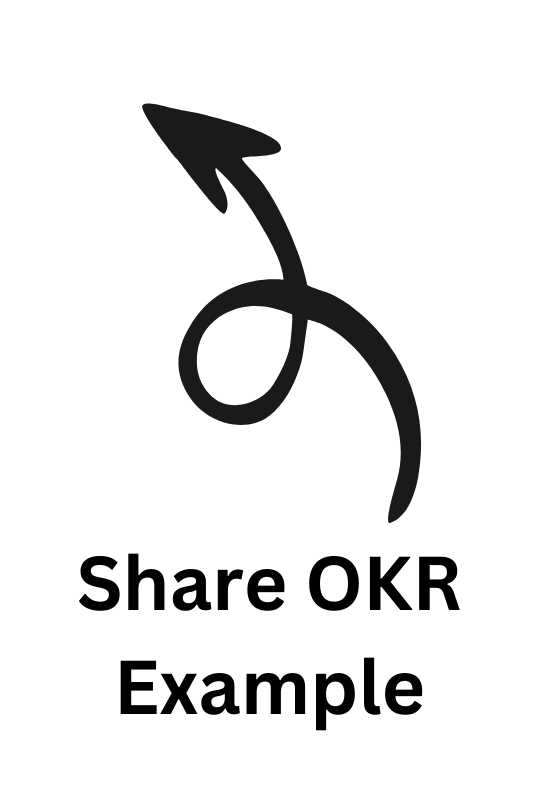As a strategy head, you are heading an approach that would help determine how to move the needle on the organizational vision. The next thing would be ensuring your business goals are challenging, aligned throughout, and, at the very least, bringing forth measurable growth. To be sure of all of that, there are OKRs.
OKRs are helpful in defining clear objectives using a structured framework and tracking the progress of key outcomes. All strategic initiatives would be aligned with business priorities, so every effort made contributes to the bigger picture.
We’ll share with you the top OKR examples for strategy heads. These will inspire you to set meaningful goals, align your teams, and drive sustainable growth. Let’s explore how you can use OKR to take your strategy to the next level!
OKR Example for Strategy Heads 1
The goal is to create and implement a strategic plan that ensures sustainable growth. This involves completing a thorough market analysis to identify major trends and emerging opportunities, improving customer satisfaction through alignment with their evolving needs, and enhancing competitive positioning.
Key results will include identifying key market trends and opportunities by the end of Q2, increasing customer satisfaction scores by 20% through strategic adjustments based on biannual surveys, and achieving a 15% improvement in competitive positioning through market share analysis and benchmarking by year-end.
Objective: Develop and Execute a Long-Term Strategic Plan to Drive Sustainable Growth
Key Results:
- Key Result 1: Complete a comprehensive market analysis and identify 3 major trends and 3 emerging opportunities.
- Key Result 2: Increase customer satisfaction scores by 20% through strategic alignment with evolving customer needs, as measured by biannual surveys.
- Key Result 3: Achieve a 15% improvement in competitive positioning based on market share analysis and competitive benchmarking.
OKR Example for Strategy Heads 2
The goal is to strengthen competitive advantage through strategic partnerships. This involves establishing high-impact partnerships with organizations that complement existing technologies, capabilities, or market access, expanding market reach into new or underserved regions, and collaborating on joint research and development initiatives.
Key results will include forming significant partnerships by the end of Q4, increasing market reach by 20% in targeted regions through these alliances, and working together on joint R&D initiatives to co-create innovative solutions that enhance product offerings.
Objective: Drive Strategic Partnerships to Enhance Competitive Advantage
Key Results:
- Key Result 1: Establish 3 high-impact partnerships with organizations that offer complementary technology, capabilities, or market access.
- Key Result 2: Increase market reach by 20% in new or underserved geographical regions through strategic alliances.
- Key Result 3: Collaborate on 2 joint R&D initiatives with partners to co-create innovative solutions that enhance product offerings.
Read More: OKRs for Strategic Clarity and Focus
OKR Example for Strategy Heads 3
To optimize resource allocation for maximum strategic impact, the focus is on effectively managing and directing resources to enhance overall performance and outcomes.
This involves reallocating resources from underperforming areas to high-impact strategic initiatives, ensuring that efforts are concentrated where they can make the most significant difference.
Improving the return on investment (ROI) for strategic projects will reflect better use of resources and greater effectiveness in achieving project goals.
Reducing operational costs through strategic resource optimization will enhance overall efficiency and profitability. These steps will ensure that resources are used effectively to drive strategic success and operational excellence.
Objective: Optimize Resource Allocation for Maximum Strategic Impact
Key Results:
- Key Result 1: Reallocate 20% of underperforming resources to high-impact strategic initiatives
- Key Result 2: Achieve a 25% improvement in ROI for strategic projects
- Key Result 3: Reduce operational costs by 10% through strategic resource optimization
OKR Example for Strategy Heads 4
The goal is to improve the organization’s ability to quickly adapt to market changes. This involves implementing real-time market intelligence tools, forming agile teams to address market shifts, and increasing the speed of product adjustments.
Key results will include achieving 90% adoption of market intelligence tools by key decision-makers by Q2, launching three cross-functional agile teams by the end of Q3 to deliver market-responsive initiatives, and increasing the speed of product adjustments by 20% through agile development methodologies.
Objective: Enhance Strategic Agility to Respond to Market Changes
Key Results:
- Key Result 1: Implement real-time market intelligence tools, with 90% adoption by key decision-makers to track customer preferences and competitor actions.
- Key Result 2: Launch 3 cross-functional agile teams to tackle market shifts, with each team delivering at least 2 market-responsive initiatives within six months.
- Key Result 3: Achieve a 20% increase in the speed of product adjustments based on market feedback through the adoption of agile development methodologies.
OKR Example for Strategy Heads 5
The goal is to expand market share by implementing strategic initiatives aimed at penetrating new markets and improving customer satisfaction. This involves adjusting pricing and promotional strategies, launching targeted marketing campaigns, and addressing key customer challenges.
Key results will include a 15% increase in market share through competitive pricing and promotions within the next quarter, a 25% boost in brand awareness through a new marketing campaign targeting three new customer segments within six months, and a 20% increase in customer satisfaction by addressing major challenges through targeted product improvements and support initiatives.
Objective: Increase Market Share through Strategic Market Penetration
Key Results:
- Key Result 1: Increase market share by 15% through competitive pricing adjustments and promotional strategies within the next quarter.
- Key Result 2: Launch a new marketing campaign that targets 3 new customer segments, resulting in a 25% boost in brand awareness within the next 6 months.
- Key Result 3: Identify and address 3 major customer challenges through targeted product improvements and support initiatives, leading to a 20% increase in customer satisfaction.
Read More: Marketing Strategies
OKR Example for Strategy Heads 6
To drive innovation through strategic initiatives, the focus is on fostering creativity and advancing new ideas that align with the company’s long-term goals. This involves identifying and launching innovative initiatives that are closely aligned with the company’s strategic vision, ensuring that new projects contribute to overall objectives.
Allocating a significant portion of the annual budget to innovation-focused projects will provide the necessary resources and support for developing new ideas and solutions.
Achieving a notable increase in revenue from innovative products or services will reflect the success of these initiatives in generating tangible business growth. These efforts will collectively drive innovation and contribute to the company’s strategic advancement.
Objective: Drive Innovation through Strategic Initiatives
Key Results:
- Key Result 1: Identify and launch 3 innovative initiatives that align with the company’s long-term strategy.
- Key Result 2: Allocate 15% of the annual budget to innovation-focused projects.
- Key Result 3: Achieve a 20% increase in revenue from innovative products or services
OKR Example for Strategy Heads 7
To improve strategic decision-making through data-driven insights, the focus is on enhancing the use of data to inform and guide strategic choices. This involves implementing a real-time data analytics platform that provides up-to-date information to support decision-making processes.
Increasing the use of data in strategic planning will ensure that decisions are based on accurate and comprehensive insights. Conducting regular, data-driven strategy reviews with high participation from key stakeholders will facilitate informed discussions and align strategies with data insights.
These efforts will collectively strengthen the company’s ability to make informed, strategic decisions and drive better business outcomes.
Objective: Improve Strategic Decision-Making through Data-Driven Insights
Key Results:
- Key Result 1: Implement a real-time data analytics platform that supports strategic decision-making.
- Key Result 2: Increase the use of data in strategic planning by 50%.
- Key Result 3: Conduct monthly data-driven strategy reviews with a 90% participation rate from key stakeholders 4
OKR Example for Strategy Heads 8
The goal is to create a cohesive culture where all departments are aligned with the organization’s strategic objectives. This involves establishing regular OKR reviews, facilitating cross-departmental collaboration, and enhancing communication about strategic goals.
Key results will include implementing a quarterly OKR review process with a 90% compliance rate across departments, conducting five cross-departmental workshops to align strategic priorities and promote collaboration, and developing a company-wide communication plan with monthly updates on strategic goals and progress, achieving a 90% employee engagement rate.
Objective: Foster a Culture of Strategic Alignment Across the Organization
Key Results:
- Key Result 1: Implement a quarterly OKR review process for all departments to ensure alignment with organizational goals, achieving a 90% compliance rate across teams.
- Key Result 2: Conduct 5 cross-departmental workshops to align strategic priorities and facilitate interdepartmental collaboration.
- Key Result 3: Develop and roll out a company-wide communication plan that includes monthly updates on strategic goals and progress, with a 90% employee engagement rate.
OKR Example for Strategy Heads 9
To strengthen competitive positioning through strategic differentiation, the focus is on creating distinct advantages that set the company apart in the market. This involves launching new value propositions that clearly differentiate the company from its competitors, establishing unique selling points that attract and retain customers.
Improving competitive win rates in key business segments will demonstrate the effectiveness of these differentiation strategies in gaining a competitive edge.
Increasing the company’s share of voice in the industry through targeted marketing efforts will enhance visibility and reinforce the company’s position as a leader in its field. These actions will collectively enhance the company’s competitive stance and market presence.
Objective: Strengthen Competitive Positioning through Strategic Differentiation
Key Results:
- Key Result 1: Launch 2 new differentiated value propositions that set the company apart from competitors.
- Key Result 2: Achieve a 20% improvement in competitive win rates for key business segments.
- Key Result 3: Increase the company’s share of voice in the industry by 25% through strategic marketing efforts.
OKR Example for Strategy Heads 10
To enhance customer-centricity in strategic planning, the focus is on ensuring that customer needs and feedback are central to the company’s strategic decisions. This involves integrating customer insights into a significant portion of strategic initiatives, ensuring that strategies are closely aligned with customer expectations and preferences.
Improving customer satisfaction scores for strategic projects will reflect the success of these efforts in meeting customer needs more effectively.
Conducting bi-annual customer advisory sessions with high participation will facilitate direct feedback and strengthen the connection between customer perspectives and strategic planning. These actions will collectively ensure that the company’s strategies are more responsive to and aligned with customer needs.
Objective: Enhance Customer-Centricity in Strategic Planning
Key Results:
- Key Result 1: Integrate customer insights into 80% of strategic initiatives.
- Key Result 2: Achieve a 30% improvement in customer satisfaction scores for strategic projects.
- Key Result 3: Conduct bi-annual customer advisory sessions with a 90% participation rate.
Align business goals and drive growth seamlessly with Worxmate, the best OKR software for strategy heads. Simplify goal-setting, track progress, and ensure team alignment.
👉 Book a Free Demo and experience how AI-powered OKRs can transform your strategy execution.



